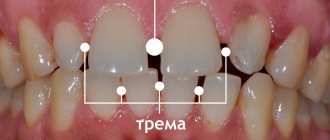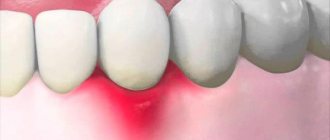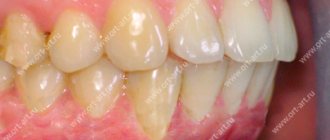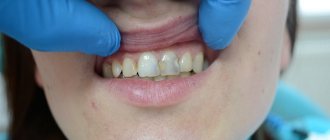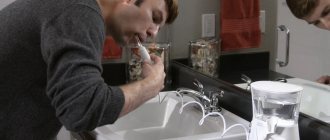Diastema is an empty space between teeth, ranging in size from one to five to six millimeters. A characteristic gap forms between the front incisors. Moreover, in some its appearance is due to heredity, in others - anomalies in the structure of the dental system.
The reason may be incorrect position of the teeth, pathologies in the structure of the frenulum, partial edentia, for example, the absence of lateral incisors or microdentia - the small size of dental crowns. Sometimes diastema is provoked by bad habits - biting pencils, pens and nails, as well as sucking a pacifier for a long time in childhood.
What is the difference between a diastema and a trema?
Interdental gaps can appear not only on the front teeth, but also anywhere in the upper or lower jaw. In this case, empty spaces are called trems. Just like diastemas, they can arise due to various factors. Among the most common are malocclusion, premature tooth loss, and heredity.
The localization of trema depends on the cause that provoked it. Thus, trema in the lower jaw appear due to the mesial relationship of the dentition, and the spaces between the canines and lateral incisors are due to partial edentia.
Why are they trying to remove the diastema?
The space between the front teeth can reach 5–6 mm, without affecting a person’s ability to work or his career opportunities. Russian stars Konstantin Raikin and Nikolai Karachentsov, their American colleague Eddie Murphy, singers Madonna, Vanessa Paradis and Alla Pugacheva reached stellar heights without being embarrassed by a small interdental gap. Moreover, today the diastema of the front teeth has actually become a passport to the world of fashion and style. At least a dozen famous models with gaps stride along the world's main catwalks. Among them are Georgia Jagger and Lara Stone, Ashley Smith and Lindsay Wixson.
All these people adequately perceive their “wrong” teeth and the problems they create. But not everyone is ready to come to terms with such a natural feature. What annoys people with gap hair the most?
- The aesthetics of a smile is violated, in their understanding.
- Lisp and stridence caused by diastema are incorrect pronunciation of whistling and hissing consonants.
- Saliva splashing during conversation and tongue visible in the lumen.
It is with such complaints that they turn to the dental clinic. To offer the optimal treatment method, doctors carefully diagnose patients, paying special attention to the childhood period of their life.
What types of diastema exist and why do they occur?
Diastemas, as well as tremata, come in different types. Experts divide them by etiology, location, and type of displacement. Doctors also distinguish between false and true diastemas separately. The latter are always a consequence of pathology, while false ones are found only in children and disappear as the teeth grow.
Symmetrical and asymmetrical diastema
Most often, the diastema is symmetrical, that is, the incisors are equidistant from the frenulum. An asymmetrical arrangement is much less common, and with it, only one incisor is displaced, the second is in the correct position.
Lateral deviation of crowns
With lateral deviation of the crowns, the roots are located correctly, the discrepancy begins only on the visible part of the teeth. Most often, this pathology is a consequence of supernumerary teeth. Also, a gap may appear due to bad habits.
Body lateral displacement
The peculiarity of this type of displacement is the complete deviation of the teeth along with the roots. It is provoked by congenital adentia, the lower attachment of the frenulum, and compaction of the middle suture on the bone tissue. In the latter case, the teeth cannot overcome the obstacle and take the correct position.
Medial inclination of central incisors
This type of diastema is the most difficult, since it simultaneously causes deviation of the teeth from the center and their rotation along the axis. The cause is almost always supernumerary teeth located between the first incisors or odontoma, a benign tumor growing in the jaw bone.
When and why does a gap appear between the incisors?
In most cases, the gap between a child’s teeth is false. It is formed due to a mismatch between the rapidly growing jaw bones and small baby teeth and disappears on its own when the bite changes. A diastema formed already with permanent teeth is called true and, in the absence of correction, remains with the person forever.
Dentists divide the reasons for its appearance into objective and local subjective. Among the objective ones the leaders are:
- hereditary factor;
- structural features of the jaw bone and attachment of the labial frenulum;
- typical orthodontic problems associated with changes in the normal position of teeth in the jawbone.
Local habits include bad habits that contribute to the “breaking apart” of teeth: prolonged sucking of a pacifier and finger, as well as a persistent commitment to chewing hard objects. In people over 30 years of age, the incisors can also “move apart” if periodontal disease is not treated. The tissues that dissolve in this process deprive the teeth of support and provoke their displacement.
To choose the right way to correct a diastema in Moscow , it is necessary not only to carry out a number of specific diagnostic procedures, but also to find out exactly when the gap became noticeable and what the patient himself associates with its appearance.
Why is an unclosed diastema dangerous?
The large distance between the teeth cannot be ignored. You need to visit an orthodontist, who will tell you what caused the pathology and whether it needs correction. At ORTHODONT CENTER clinics, the first consultation is free. If the doctor suspects serious changes in the structure of the jaws, he will conduct a detailed examination using X-ray equipment or a CT scanner.
If the situation is unfavorable, the specialist will offer various types of correction that can remove the cleft and at the same time eliminate the problems associated with it. Untreated diastema can lead to gum disease, the formation of “pockets” in the periosteum, and premature tooth loss. Due to the diastema, incorrect pronunciation of hissing and whistling sounds may occur.
Is it necessary to remove the gap between teeth if the distance is not large?
A pronounced gap between the teeth causes psychological discomfort and spoils the appearance of the smile. Because of this, many people are looking for a “folk” method that will help them close the gap between their teeth. However, this problem is not only aesthetic.
The main consequences of the presence of diastemas and three:
- - formation of malocclusion;
- — violation of diction;
- - increased risk of developing carious lesions;
- - increased risk of developing gum disease.
Specialists from Leonid Gorbunov’s orthodontic studio will help you get rid of the problem. Our doctors will provide professional advice and tell you how to remove gaps between teeth at any age. They will also provide the full range of treatment for the problem.
Ways to eliminate gaps between teeth
Surgical plastic surgery
Surgical methods for correcting diastema can be used either alone or in combination with other measures. In childhood, sometimes it is enough to reduce the tension of the frenulum so that the teeth take the correct anatomical position. If the cause of the diastema is the supernumerary of teeth, their removal alone is not enough - alignment is required with braces or orthodontic caps.
Surgical intervention is also required for various types of disposition, when teeth erupt outside the dentition. In this case, the incorrectly located tooth is removed and orthodontic movement of the adjacent teeth is carried out.
Implantation
Braces
Implantation
Unfortunately, with diastema, teeth cannot always be straightened. Particular difficulties arise with medial inclination of the incisors. If the rotation of the tooth is too great, the specialist may decide to remove it and replace it with an implant. Since the procedures are carried out over a short period of time, the process of bone loss does not have time to begin, and implantation does not cause difficulties.
Braces
Braces are the most popular way to correct orthodontic problems, including those that cause the formation of diastema. Their main advantages are high efficiency and the ability to be used in patients of all ages. Braces are installed for both children and adults. But due to the nature of the growth of the dental system, which continues until the age of 18-20, correction requires less time in younger patients. Treatment after this age, depending on the severity of the pathology, can last two to three years.
Wearing braces requires a conscious approach - you should not skip scheduled visits to the orthodontist, nor should you remove the installation yourself. After completion of the main treatment, a retention period begins, during which the doctor prescribes the use of mouth guards or plates. If they are neglected, the teeth may return to their original position and the correction will have to be done again.
Crowns and veneers
Crowns and veneers can be used as primary and additional correction methods. With lateral deviation, when the roots of the teeth are located evenly and do not need to be turned, the gap is simply closed with crowns. Veneers, in this case, are installed on adjacent teeth to hide the increased transverse size of the central incisors.
The doctor may also recommend using veneers on the front teeth if, after eliminating the diastema, it turns out that the crowns are not in the best condition. It is important to understand that if the cleft is a consequence of malocclusion, overcrowding, disposition or other dental pathology, it makes no sense to install veneers until the problem is eliminated.
Aligners (aligners)
Orthodontic plate
Records
Plates are mainly used to treat diastema in children when the jaws have not yet formed and less effort is required to correct the irregularities. Plates are removable structures that can be installed on one or two rows of teeth at once. They consist of a palatal part and arches, which are located in such a way as to exert pressure on the teeth and, thereby, help them move into the desired position.
The plates are removable and non-removable. The latter, like braces, are installed for a long time, and, at certain intervals, the doctor adjusts their position and changes the tension force. When treating with removable structures, several devices may be needed per course of treatment.
Plates are the best solution when it comes to correcting diastema in children. They do not cause severe discomfort even at the initial stage of treatment, they can be removed while eating, plus, the devices themselves are inexpensive.
The disadvantage of the plates is the impossibility of their use as the main method of treatment in adult patients and in complex clinical cases.
Mouthguards
Mouth guards are removable structures that are placed over the teeth in the form of a cover. Despite the softness of the material, it puts enough pressure on the teeth to return them to their correct position. Several trays are made for the entire treatment period, and the size of each subsequent design is reduced. Thanks to this, the movement takes place without pain and discomfort. Another important advantage of mouth guards is transparency. When worn, they are practically invisible to others. Among the disadvantages are the inability to use for complex cases and the rather high cost.
Cosmetic correction and artistic restoration
These methods are very similar - the gap between the teeth is closed using filling materials. If phosphate cements are used during the work, this is considered a cosmetic correction. The use of modern photopolymer materials allows us to talk about artistic restoration. The difference between the methods is in the external result and durability. Artistic restoration allows you to achieve better aesthetics, and thanks to the strength of filling materials, the result lasts several times longer.
However, these two methods are purely cosmetic and do not solve the problem itself. They are only suitable in cases of lateral deviation of the crowns. At the same time, no matter what materials are used, the patient will have to forget about solid foods such as seeds, crackers or nuts.
Recommendations from our orthodontist for the prevention of gaps
The main preventive measure to prevent the development of diastema and three is a timely visit to the orthodontist and following his recommendations. We strongly recommend showing your child's teeth to our dentist. After all, it is much easier to prevent the problem in childhood. Preventive examinations are recommended every 6 months.
Basic preventive measures:
- — full compliance with daily oral hygiene;
- - varied and nutritious nutrition for the child, including solid foods;
- — timely suppression of bad habits in a child.
If you notice a pronounced gap between the front or any other teeth, it is better to immediately contact the specialists of the dental studio. The sooner treatment is started, the faster and easier it is to achieve a positive result.
Posted by:
Prevention of recurrence of diastema
Relapses in orthodontic treatment, unfortunately, occur frequently. This is especially frustrating considering how much time and money is involved in fixing the problem. In the case of diastema, its appearance can be caused by various reasons. The most common are incorrectly selected treatment and neglect of the orthodontist’s recommendations during the retention period.
Sometimes patients refuse the necessary surgical treatment or wearing braces, and insist on “simple” correction methods, for example, installing crowns or masking the gap with composite materials. But since the problem remains unresolved, the diastema will return.
Likewise, she will not keep you waiting if, after treatment, the patient decides to ignore the orthodontist’s recommendations and does not wear retention devices.
Is it possible to eliminate it at home?
There are situations when there is simply no money for treatment, but you really want to get rid of the defect. Unfortunately, the incisors cannot be adjusted at home without the intervention of a doctor; only a professional can help you with this using certain equipment and materials.
The only acceptable option for how to close the gap between the lower teeth is to make a homemade analogue of the braces system. It is necessary to tighten the twisted units tightly every time before going to bed for a long time. This is a relatively effective method, so there is no guarantee that it will help or not cause harm. The best way out in any such situation is to contact a qualified orthodontist.
Is it possible to fix a hole between teeth at home?
It is impossible to remove diastema at home. To carry out effective correction, specialists use a whole range of diagnostic measures, as well as devices that are manufactured specifically for the patient. It is naive to believe that the problem can be eliminated simply by tying the two front teeth with floss. Moreover, such manipulations are dangerous, as they can damage the gums or the teeth themselves.
Sometimes you can hear stories about how a child's teeth were bandaged and the cleft disappeared. But, in this case, we are talking about a false diastema, which goes away on its own without any intervention.
Is it worth getting rid of the gap?
How the gap between the teeth is treated is up to its owner to decide. Mostly, residents of different countries are sure that those with a gap-shaped smile are warm-hearted and pleasant people with whom it is easy to make friends and interesting to communicate. Shcherbinka is considered a good omen, foreshadowing well-deserved fame and luck in all endeavors among most peoples. So don’t be ashamed of the gap between your teeth and perceive it as a drawback. This is a virtue that few have.
Celebrities, having this piquant accent in their appearance, are in no hurry to get rid of it. After all, you can live your life focusing only on happy predictions. Although if you are categorically unhappy with your smile, modern medicine can fix everything. But is it worth getting rid of such a unique gift of nature?
Found a violation? Report content
How to prevent diastema in a child
If diastema is a common occurrence among relatives, the parents of a small child should inform the dentist about this when the child is 2-3 years old. The specialist will observe the dynamics and, if necessary, offer age-appropriate types of correction.
Among the general recommendations on how to prevent gaps between teeth in children, the main one is to ensure that the child does not develop bad habits, such as biting nails, pencils and pens, and sucking fingers.
Causes of gaps between teeth
The main predisposing factors for the development of the defect:
- - presence of gaps in close relatives;
- - excessively pronounced interdental gingival papillae;
- — anomaly in the location of the labial frenulum;
- - delayed replacement of milk teeth with permanent ones;
- — congenital defects in the development of the dentofacial apparatus;
- — partial edentia or supernumerary teeth;
- - incorrect position of teeth (bite anomalies);
- - gum disease;
- - teeth are too small;
- — bad childhood habits (sucking pacifiers, fingers, chewing pens, pencils, etc.);
- - traumatic damage to the anterior teeth.
It is possible to prevent the occurrence of a gap between the front teeth by preventing diastema in childhood. All you have to do is take your child for a consultation to our clinic in St. Petersburg and get professional advice from an orthodontist.
Let's sum it up
Thus, diastema, as the distance (large hole, gap) between the front teeth is called, is a defect that can be eliminated in various ways. The optimal treatment method is selected by the attending physician depending on the causes of the pathology and the complexity of the situation. Some people live with small gaps all their lives without experiencing psychological discomfort. If indications for correction still exist, it is recommended not to delay the procedure, since an unclosed gap leads to speech defects, malocclusion and other problems that affect the quality of life.



